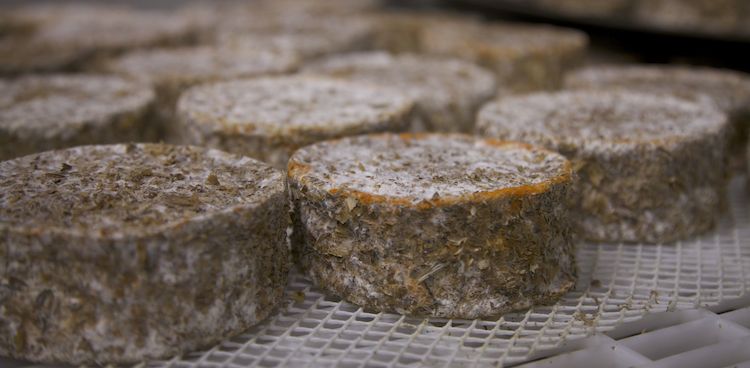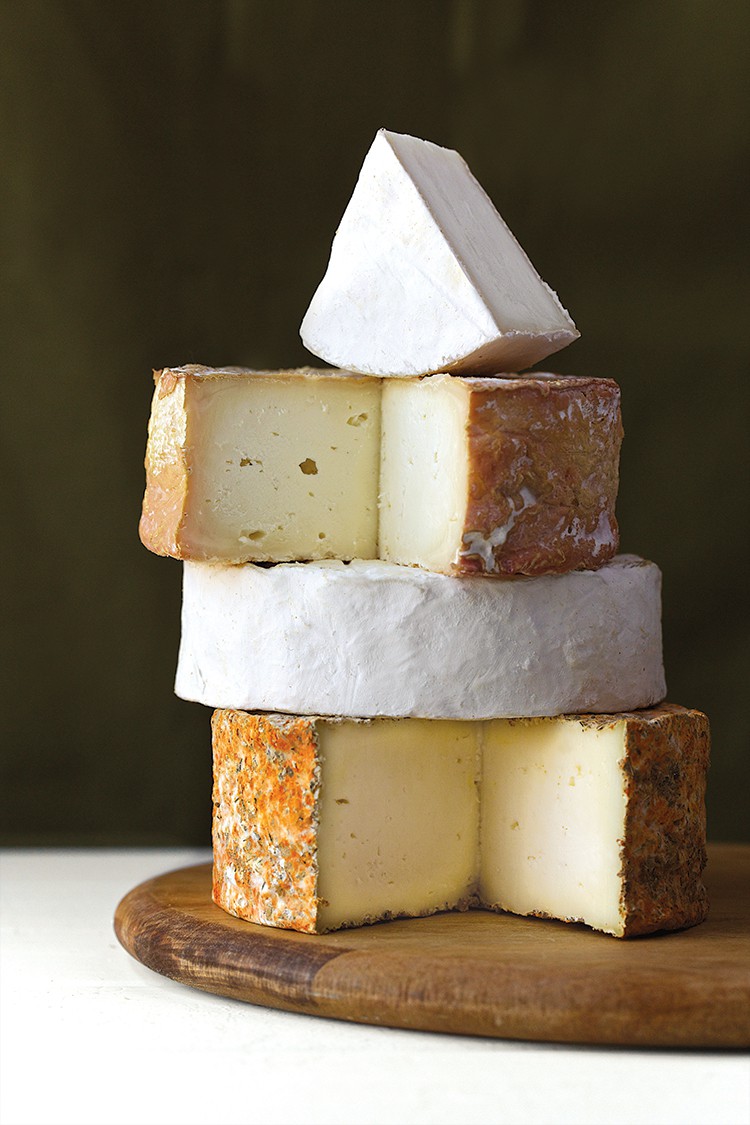
This article was published in our Summer 2014 issue (Vol. 6, Issue 4). To have more stories like this delivered to your doorstep six times per year, become a subscriber. Standard 1-year subscriptions start at $30.
As I bear left on Shaker Museum Road in Old Chatham, N.Y., a red barn positioned in the palm of rolling pastures comes into view. No one is in sight as I park my car, but a self-serve stand holding cheeses tells me I’m in the right place. The slam of my car door reverberates through stillness as I head toward the barn on foot. Inside, crossbred East Friesian and Lacaune sheep lift their heads, wide-eyed, to greet me.
It’s a tranquil morning in the Hudson Valley, but this farm is hardly dormant. I’m on the grounds of Old Chatham Sheepherding Company, the largest sheep dairy in the United States. I work as an affineur, aging cheeses and coddling wheels from rindless states to fully developed cheeses. I know Old Chatham’s Kinderhook Creek cheese, and its aged siblings, C Local and Hudson Flower, intimately through my job, but this morning’s introduction adds a special layer of context. Getting to know the sheep (and soon, the cheesemakers) feels a little like meeting the parents of a child I raise.
The Early Bloomer: Kinderhook Creek
Added to Old Chatham’s lineup in 2011, Kinderhook Creek takes its name from the brook abutting the farm’s grazing pastures. The cheese is made year-round—no small feat, as sheep have a much shorter lactation cycle and lower yield than cows. Generally, this means raising a larger herd to increase milk volume, but at Old Chatham space is tight.
“We just can’t add more sheep,” says owner Tom Clark. “We’re kind of bursting at the seams right now.” (That may soon change, however; Clark, with his wife Nancy, has partnered with former Cornell University professor David Galton and his company Shepherd’s Way. The team plans to increase milk production by year’s end by establishing a new farm north of Ithaca, N.Y.).
Of the nearly 1,800 sheep currently living on the farm here, about 730 are milking at once, but more milk is always needed. To maintain an ample supply, Old Chatham seasonally supplements its own milk with an influx from 13 local Amish farms.
On the morning of my visit, creamery manager Todd Pontius leads me into a bustling production room where head cheesemaker Wes Tennyson and crew are setting up.
“It’s like making cheese in a battleship, and Wes is the captain,” says Pontius dryly, and I see what he means. Space is at a premium here, too. Tennyson and four supporting cheesemakers work quickly and meticulously, sanitizing bins and stacking cylindrical cheese molds across a long stainless-steel table.
Pasteurization begins before 6 a.m. Once the milk cools slightly, starter culture is added and the team awaits a drop in pH. Next, the milk is pumped from the pasteurizer vat to two giant white holding bins on wheels. A vial is passed my way so I can taste the still-warm milk. Its flavor is surprisingly complex: honey, fresh grass, and clean undertones.
“We try to keep things simple so that the milk speaks for itself,” says Pontius, as Tennyson shoulders the milk-heavy bins closer to the table. He measures and adds rennet. Today’s milk totals 105 gallons—low compared to the increased flow that will come with a few more rounds of lambing.
After testing for a clean break, Tennyson cuts the curd, yielding pudding-like cubes in pale yellow whey. One scoop at a time, he ladles curd into plastic molds to drain.
A few hours later, still bound by molds, the new, spongy wheels are flipped. Tomorrow, the molds will be removed and the cheeses submerged for an hour in a saltwater brine before being transferred to the drying cave. The batch is dried for four to seven days to remove surface humidity.
In its “green,” or rindless, form, Kinderhook Creek is shipped to an unassuming warehouse in Long Island City: the cave-aging facility of Murray’s, New York City’s oldest cheese shop and one of a handful of domestic retailers with aging rooms akin to those used traditionally in Europe.
Inside the warehouse, four temperature- and humiditycontrolled caves and a drying room are calibrated to ripen and store cheeses of various styles. This glorified cheese spa is where I spend most of my days, and it’s where I’m used to meeting Kinderhook Creek.
Interest in affinage is growing in the US, perhaps because the process is essentially very American: A tension between tradition and innovation leads to transformation and individuality. Old Chatham’s choice to outsource some aging to Murray’s mirrors the pioneer mindset that Tom and Nancy Clark employed when they founded the dairy in 1993. The husband-and-wife team cut their first curds just as the American palate was warming up to the notion of sheep’s milk cheeses. Similarly, the European practice of relying on affineurs is taking hold among domestic artisan cheesemakers who may not have the bandwidth or facilities to nurture their own products.
At Murray’s, Kinderhook Creek resides in the bloomyrind cave, an incubator for delicate soft-format cheeses. A pure sheep’s milk wheel, Kinderhook Creek develops a captivating texture as it ages: Dense, pristine white paste with a silky creamline that oozes like lava beneath the rind. After several weeks, the 14-ounce disc becomes soft and spreadable. Tangy, buttery notes dominate its flavor profile. Hints of fresh radish, chive, and grass follow, with strong mushroom characteristics in its rind.

From top, Kinderhook Creek, C Local, and Hudson Flower, available for purchase through our summer centerfold offer with Murray’s Cheese.
The Wild Child: C Local
In 2011, Brian Ralph took over management of Murray’s caves, and he began experimenting. “Those were the cowboy days,” Ralph recalls. “We started washing Kinderhook Creek [in a brine solution] and had it tucked in the back corner on the lowest shelf so that no one would see it. Everything was by feel. After about a week and a half we started to see orange matting on the rind.”
A few weeks later, the team tasted its creation. The entire wheel was devoured in one sitting. Old Chatham’s response was equally favorable, giving Murray’s the green light to further develop and sell the incipient cheese.
“As a young affineur, working with the producer and having them support a new idea—that was a triumph for me,” Ralph says.
Murray’s settled on the name C Local, choosing the C in part to reference Chatham and Local to credit a beer incorporated in the cheese-washing brine: Brooklyn Brewery’s Brooklyn Local 2. New Yorkers know C Local as the name of a train that runs from Brooklyn to Manhattan’s upper west side. “If you’ve ever ridden the C train, you know that sometimes—most of the time— it gets fairly pungent,” Ralph says. “It’s underground; the caves are underground. It felt right.”
Today, fresh wheels of Kinderhook are unloaded at Murray’s biweekly. After a few brine washes and two to three weeks of aging, the cheese develops a pastel orange, slightly tacky rind, which brightens with each boozy bath. Microflora in the washed-rind cave help the bacterial community on C Local’s rind to ripen the paste, bringing forth meaty, fresh-baked bread aromas and a punch of brassica flavors such as Brussels sprouts. The creamline oscillates between runny and custardy; the paste is at first flaky and then spoonable. The orange rind is sometimes masked by tufts of bloomy white mold: Kinderhook Creek peeking out from behind her funkier sister.

Dehydrated hops are blended with rosemary, lemon thyme, and chervil to form a kind of potpourri that coats Hudson Flower.
The Naturalist: Hudson Flower
The success of Murray’s partnership with Old Chatham formalized and launched Murray’s Cave Master Reserve program. The project is now responsible for a line of exclusive, cave-aged cheeses whose rinds and flavor profiles are developed using various affinage techniques.
In 2013, Kinderhook Creek inspired another spin-off: Hudson Flower, loosely based on the herb-covered Corsican Fleur du Maquis cheese, also known as Brin d’Amour. In a quest to flavor Kinderhook Creek’s earthy youngest sister, Ralph experimented with over 25 varieties of hops before finally settling on Ahtanum and Czech Saaz for their fruity balance. Dehydrated hops are blended with rosemary, lemon thyme, and chervil to form a kind of potpourri that coats the cheese.
When aged three to six weeks, the herbs and hops on Hudson Flower’s edible rind resemble forest floor beneath a dusting of snow. The mix imparts herbaceous, piney flavors, with lemon and floral notes. After a few weeks in the natural-rind cave, the red-orange mold Sporendonema casei shows up, indicating that the cheese is ripe. “If you’re going to geek out on molds, this is one of the prettiest ones you can find,” Ralph says.
They say it takes a village to raise a child. The same, I’ve learned, is true of cheese. From the moment milk flows into the vat at Old Chatham Sheepherding Company, multiple experts use intuition and science to help each sheep’s milk cheese figure out what it wants to be when it grows up. In this case, the outcomes are as different as they are delicious.
This article was published in our Summer 2014 issue (Vol. 6, Issue 4). To have more stories like this delivered to your doorstep six times per year, become a subscriber. Standard 1-year subscriptions start at $30.







